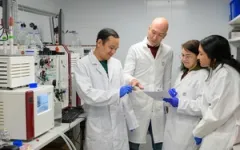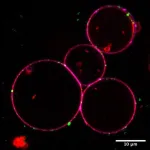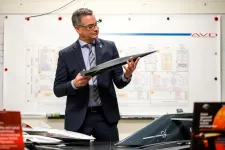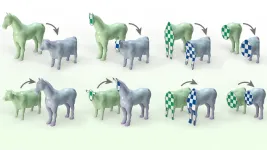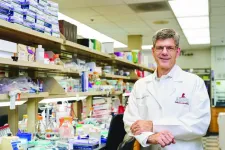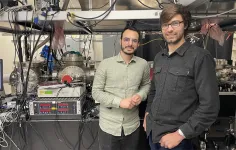(Press-News.org) A University of Texas at Arlington engineering researcher who studies traumatic brain injuries has received funding to use computer motion simulation that replicates the movements of a person performing activities that could lead to injury.
The project, funded by a nearly $1 million grant from the Office of Naval Research Defense University Research Instrumentation Program (DURIP), will use real-time data of phantom head and phantom body reactions to ascertain what physical injuries could come from those motions.
Ashfaq Adnan, a UT Arlington professor in the Department of Mechanical and Aerospace Engineering, is leading the project, called “System for Remote Mapping of Motion Data and Real-Time Damage Risk Analysis of Biologically Relevant Materials Using Digital Engineering.” For its current phase, he is building a system that will enable him to replicate the motion of a moving object, be it a moving vehicle or a person.
“Imagine you’re on a speed boat in the Pacific Ocean and there’s a lot of shaking and vibrating going on,” Adnan said. “Through the use of sensors and what they record, you’re then able to create the same motions in the lab and analyze them to find what could lead to injury.”
He believes this project will greatly improve upon current sensor data because of its precision, speed and ability to generate both effects of the motion and risk analysis. An integrated system could perform injury risk analysis in seconds compared to conventional systems, where data has to be downloaded, taken to a lab, and compiled before a computer system produces recommendations.
“It’s called digital engineering, which is a new field to computationally replicate a real-life environment in 3-dimenstional space,” Adnan said. “It builds a model of motion and impact on the computer given the person’s size. Then we test that in real time.
“We could potentially track your accident experience, create a digital twin of you in our lab and analyze if you are at immediate injury risk. We could use that digital twin of you and put it through certain actions to measure the impact of those actions on your life.”
The battlefield and the football field are obvious theaters in which head or body trauma might happen, and for which current technology aimed at preventing or reducing injuries often takes a one-size-fits-all approach. Adnan said his new system could also lead to wearable sensors for older adults that alerts caregivers or health care providers to extreme motions, such as falls.
Erian Armanios, chair of the Department of Mechanical and Aerospace Engineering, said Adnan’s project is bound to better the lives of many.
“Dr. Adnan’s research in traumatic brain injuries continues to push the boundaries of knowledge and bring us closer to understanding how best to detect and treat these injuries,” Armanios said. “The addition of this equipment sets UTA apart and improves quality of life for post-traumatic injuries.”
DURIP grants support university research infrastructure essential to high-quality Navy-relevant research. The grant is used to acquire research instrumentation that is necessary to carry out such cutting-edge work.
END
Digital engineering to reduce risks that lead to brain injuries
Office of Naval Research grant will help UTA explore conditions that lead to brain injuries
2023-05-24
ELSE PRESS RELEASES FROM THIS DATE:
A look into the heart of cellular waste disposal
2023-05-24
To prevent our body’s cells from overflowing with garbage and to keep them healthy, the waste inside them is constantly being disposed of. This cleaning process is called autophagy. Scientists have now, for the first time, rebuilt the complex nanomachine in the laboratory that starts this process – and it works quite differently from other cellular machines. The researchers’ new insights could help open up new approaches for the treatment of cancer, immune disorders, and neurodegenerative diseases in ...
Designing a next generation hypersonic demonstrator
2023-05-24
Today, large commercial jets fly around 580 mph. The Lockheed SR-71 Blackbird introduced in 1966 is the fastest supersonic jet vehicle in the world, reaching speeds of more than 2,200 mph, nearly four times faster than a commercial jet.
The fastest rocket-powered hypersonic vehicle developed in the late 1960s carrying a human has been the North American X-15, reaching a top speed of 4,520 mph, twice that of the SR-71.
Recently, the U.S. Air Force has awarded a contract to engineer Project Mayhem with the goal to reach 4,603 mph. Now, imagine a vehicle that could fly much faster, maybe even above 6,905 mph, which is beyond nine times the speed of sound.
The University of Texas at Arlington’s ...
Confusion over VAERS: Why the vaccine safety reporting system should be renamed
2023-05-24
PHILADELPHIA – The federal health system for reporting “adverse events” after vaccination, known as VAERS, is designed to assist in the early detection of complications and responsive action. But when the pandemic and advent of new vaccines for Covid-19 turned a spotlight on this formerly little-known system, the flood of web and social media references to it was accompanied by confusion about what the system is and what the reports in it signify.
A new report from the Annenberg Public Policy Center examines misconceptions about the government’s Vaccine Adverse ...
A better way to match 3D volumes
2023-05-24
CAMBRIDGE, MA — In computer graphics and computer-aided design (CAD), 3D objects are often represented by the contours of their outer surfaces. Computers store these shapes as “thin shells,” which model the contours of the skin of an animated character but not the flesh underneath.
This modeling decision makes it efficient to store and manipulate 3D shapes, but it can lead to unexpected artifacts. An animated character’s hand, for example, might crumple when bending its fingers — a motion that resembles how an empty rubber glove deforms rather than the motion of a hand filled with bones, tendons, ...
Chemical Insights Research Institute and the Campus Safety, Health, and Environmental Management Association publish guidance for the safe use of 3D printing in institutions of higher education
2023-05-24
Atlanta (May 24, 2023) - Chemical Insights Research Institute (CIRI) of UL Research Institutes and the Campus Safety, Health, and Environmental Management Association (CSHEMA), announce the publication of, “UL 200B: Guidance Document for Safe Use of 3D Printing for Institutions of Higher Education.”
The availability of 3D printing has fostered creative and innovative learning experiences for many within the large population of students in higher education. There are roughly 17.3 million undergraduates in the U.S. alone. Because 3D printers are affordable compact, and user friendly, they can ...
SWI/SNF complexes “bookmark” cell identity during division
2023-05-24
(Memphis, Tenn.—May 24, 2023) When a cell divides, it retains information about how to grow and instructions about what type of cell to become. Scientists at St. Jude Children’s Research Hospital have gained a new understanding of how these processes can work, revealing a previously unappreciated role for the SWI/SNF chromatin remodeling complex. The study was published today in Nature.
When a cell undergoes differentiation, stem cells (the earliest cells that develop) undergo changes that transform them into a different type of cell, typically one with a more specialized function (such as a skin or muscle cell). As ...
Watching molecules relax in real time
2023-05-24
– By Rachel Berkowitz
Designing the next generation of efficient energy conversion devices for powering our electronics and heating our homes requires a detailed understanding of how molecules move and vibrate while undergoing light-induced chemical reactions. Researchers at the Department of Energy’s Lawrence Berkeley National Laboratory (Berkeley Lab) have now visualized the distortions of chemical bonds in a methane molecule after it absorbs light, loses an electron, and then relaxes. Their study provides insights into how molecules react to light, which can ultimately be useful for developing new methods ...
Announcing the Johnson & Johnson nursing innovation fellows
2023-05-24
PHILADELPHIA (May 24, 2023) – The University of Pennsylvania School of Nursing is pleased to announce that ten teams from health systems around the country have been selected for the Johnson & Johnson Nurse Innovation Fellowship Program (JJNIF), powered by Penn Nursing and the Wharton School–a ground-breaking, one-year, team-based nursing fellowship for Chief Nursing Officers, nurse executives, and senior nurse leaders.
The fellowship is unique in that two nurse leaders – one Chief Nursing Officer or nurse executive and one other senior ...
Tambourine announces the ALS breakthrough research fund, releases inaugural request for proposals
2023-05-24
Washington, DC (May 24) – Tambourine, in partnership with the Milken Institute Center for Strategic Philanthropy, today announced the ALS Breakthrough Research Fund and released the Fund’s first Request for Proposals (RFP). The Fund seeks to change how we understand and treat amyotrophic lateral sclerosis (ALS) by supporting innovative basic and discovery-focused research around the world. It particularly focuses on soliciting and funding creative, high-risk, high-reward ideas that might not otherwise fit existing grant programs but hold the potential to ...
MD Anderson Research Highlights for May 24, 2023
2023-05-24
HOUSTON ― The University of Texas MD Anderson Cancer Center’s Research Highlights showcases the latest breakthroughs in cancer care, research and prevention. These advances are made possible through seamless collaboration between MD Anderson’s world-leading clinicians and scientists, bringing discoveries from the lab to the clinic and back.
Recent developments include a new treatment option for relapsed/refractory mantle cell lymphoma, a better understanding of protein variants that trigger tumor cell death and activate ...
LAST 30 PRESS RELEASES:
Autistic and non-autistic faces may “speak a different language” when expressing emotion
No clear evidence that cannabis-based medicines relieve chronic nerve pain
Pioneering second-order nonlinear vibrational nanoscopy for interfacial molecular systems beyond the diffraction limit
Bottleneck in hydrogen distribution jeopardises billions in clean energy
Lung cancer death rates among women in Europe are finally levelling off
Scientists trace microplastics in fertilizer from fields to the beach
The Lancet Obstetrics, Gynecology, & Women’s Health: Taking paracetamol during pregnancy does not increase risk of autism, ADHD or intellectual disabilities, confirms new gold-standard evidence review
Taking paracetamol during pregnancy does not increase risk of autism, ADHD or intellectual disabilities
Harm reduction vending machines in New York State expand access to overdose treatment and drug test strips, UB studies confirm
University of Phoenix releases white paper on Credit for Prior Learning as a catalyst for internal mobility and retention
Canada losing track of salmon health as climate and industrial threats mount
Molecular sieve-confined Pt-FeOx catalysts achieve highly efficient reversible hydrogen cycle of methylcyclohexane-toluene
Investment in farm productivity tools key to reducing greenhouse gas
New review highlights electrochemical pathways to recover uranium from wastewater and seawater
Hidden pollutants in shale gas development raise environmental concerns, new review finds
Discarded cigarette butts transformed into high performance energy storage materials
Researchers highlight role of alternative RNA splicing in schizophrenia
NTU Singapore scientists find new way to disarm antibiotic-resistant bacteria and restore healing in chronic wounds
Research suggests nationwide racial bias in media reporting on gun violence
Revealing the cell’s nanocourier at work
Health impacts of nursing home staffing
Public views about opioid overdose and people with opioid use disorder
Age-related changes in sperm DNA may play a role in autism risk
Ambitious model fails to explain near-death experiences, experts say
Multifaceted effects of inward foreign direct investment on new venture creation
Exploring mutations that spontaneously switch on a key brain cell receptor
Two-step genome editing enables the creation of full-length humanized mouse models
Pusan National University researchers develop light-activated tissue adhesive patch for rapid, watertight neurosurgical sealing
Study finds so-called super agers tend to have at least two key genetic advantages
Brain stimulation device cleared for ADHD in the US is overall safe but ineffective
[Press-News.org] Digital engineering to reduce risks that lead to brain injuriesOffice of Naval Research grant will help UTA explore conditions that lead to brain injuries

